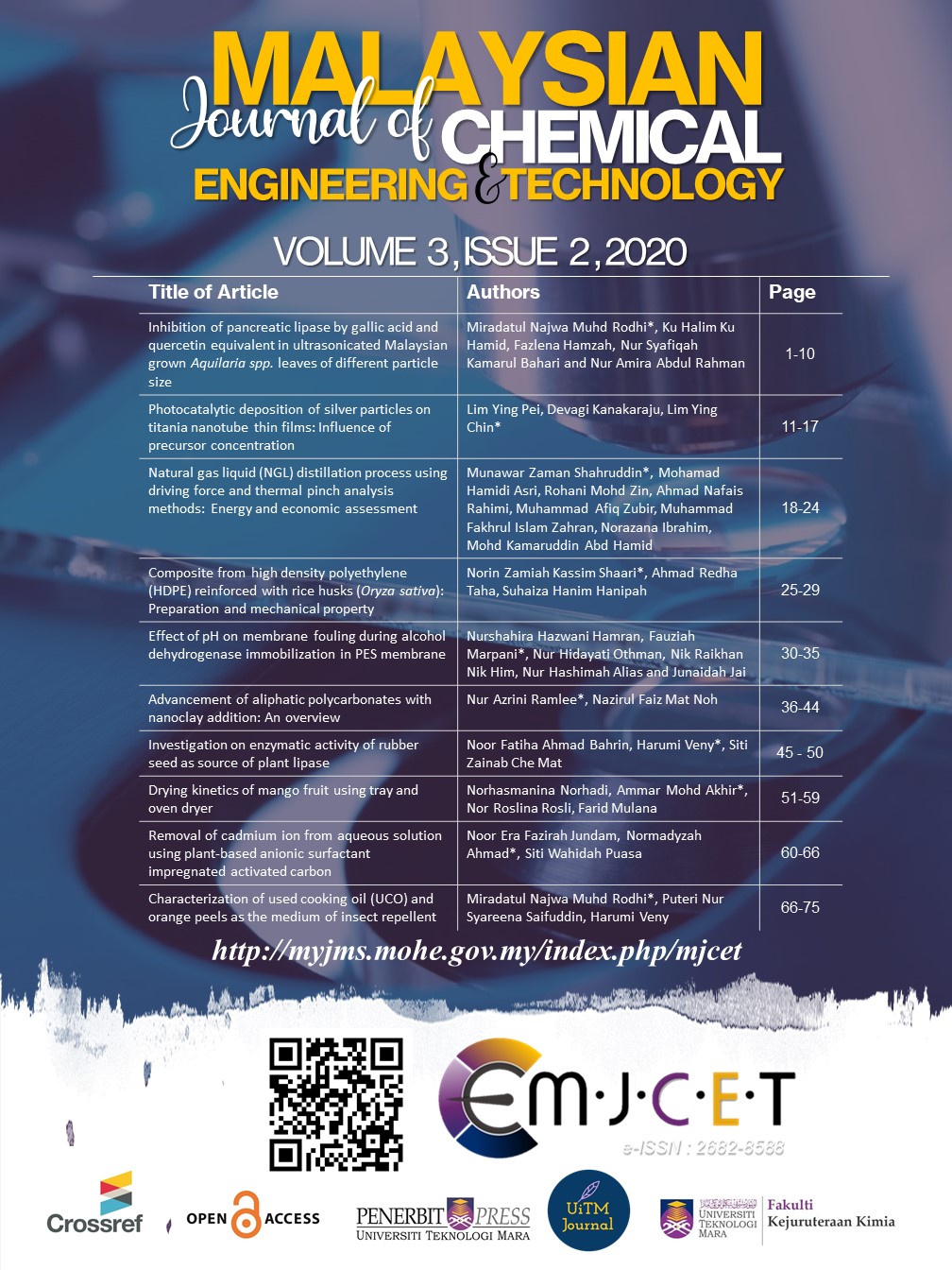Investigation on enzymatic activity of rubber seed as source of plant lipase
DOI:
https://doi.org/10.24191/mjcet.v3i2.10938Keywords:
Rubber seed, Enzymatic activity, Lipase, hydrolysis, Non-edible seedAbstract
Rubber seed is a non-edible seed that is abundantly available and considers agricultural wastes. A potential lipase from rubber seed was examined based on the enzymatic activity and its application in the hydrolysis reaction. The enzymatic activity characterization study was determined based on p-nitrophenol release in the hydrolysis reaction. The initial evaluation showed that temperature and pH significantly influence the reaction. The optimum condition based on enzymatic activity for rubber seed was found at 30 ℃ and pH 8. The rubber seed lipase extract was then used in enzymatic hydrolysis reactions of rubber seed oil, palm oil, and canola oil. The highest FFA percentage of 63% was found from the rubber seed oil. The results indicate that rubber seed extract has shown its potential enzymatic activity. However, further studies need to be done to apply this rubber seed in various lipase catalysed reactions.
References
A Hoppe, R. R Theimer, (1996). Titrimetric Test for Lipase Activity Using Stabilized Triolein Emulsions, Phytochemistry. 42(4). 973–978
A. Rajendran, A. Palanisamy, and V. Thangavelu, (2009). Lipase Catalyzed Ester Synthesis for Food Processing Industries, Brazilian Arch. Biol. Technol. vol. 52 (1). 207–219.
A. S. Ramadhas, S. Jayaraj, and C. Muraleedharan,(2005). Biodiesel production from High FFA Rubber Seed Oil, Fuel.84(4). 335–340.
F. Hasan, A. A. Shah, and A. Hameed, (2009). Methods for Detection and Characterization of Lipases: A Comprehensive Review, Biotechnol. Adv., 27(6). 782–798.
J. Senrayan and S. Venkatachalam, (2018). SolventAssisted Extraction of Oil from Papaya (Carica Papaya L.) Seeds: Evaluation of Its Physiochemical Properties and Fatty-Acid Composition, Sep. Sci. Technol.I53(17). 2852–2859.
K. C. Santos et al.,(2013). Characterization of the Catalytic Properties of Lipases from Plant Seeds for the Production of Concentrated Fatty Acids from Different Vegetable Oils, Ind. Crops Prod. 49. 462–470.
M. Avramiuc, (2016). Comparative Study on The Lipase Activity From Plant Sources, Under Various Conditions of pH, Temperature and Substrate, XV (1).. 21–28.
M. Barros, L. F. Fleuri, and G. A. MacEdo, (2010). Seed Lipases: Sources, Applications and Properties-A Review, Brazilian J. Chem. Eng. vol. 27 (1). 15–29.
M. Florkin and E. H. Stotz, (1965). Comprehensive Biochemistry, Elsevier Publishing Company.
M. L. Shuler, F. Kargi, & M .DeLisa,. (2001). Bioprocess Engineering Basic Concepts (2nd).
N. A. Turner and E. N. Vulfson, (2000). At What Temperature Can Enzymes Maintain Their Catalytic Activity? Enzyme Microb. Technol.27(1–2). 108–113.
O. U. Njoku, I. C. Ononogbu, and F. U. Eneh, (1996. Measurement of Lipase Activity In Rubber ( Hevea brasiliensis ) Seed, J. Am. Oil Chem. Soc., 73(11). 1471–1473.
P. P. Polizelli, F. D. A Facchini, & G. O.BonillaRodriguez, (2013). Stability of a Lipase Extracted from Seeds of Pachira aquatica in Commercial Detergents and Application Tests in Poultry Wastewater Pretreatment and Fat Particle Hydrolysis, Enzyme Research. 1–6
R. E. Wrolstad et al., (2005). Handbook of Food Analytical Chemistry. vol. 1–2.
R. Wilfried, M. Mounguengui, C. Brunschwig, B. Baréa, P. Villeneuve, and J. Blin , (2013). Are plant Lipases a Promising Alternative to Catalyze Transesterification for Biodiesel Production ?, Prog. Energy Combust. Sci. 39(5). 441–456.
S. S. Isbilir, H. M. Ozcan, and H. Yagar, (2008). Some Biochemical Properties of Lipase from Bay Laurel (Laurus nobilis L.) Seeds, J. Am. Oil Chem. Soc. 85(3). 227–233.
S. Seth, D. Chakravorty, V. K. Dubey, and S. Patra,(2014). An Insight into Plant Lipase Research-Challenges Encountered, Protein Expr Purif., 95. 13–21.
Y. Mazaheri, M. Torbati, S. Azadmard-Damirchi, and G. P. Savage, (2019). Effect of Roasting and Microwave Pre-Treatments of Nigella Sativa L. Seeds on Lipase Activity and The Quality of the Oil, Food Chem.274. 480–486.
Y. Yesologlu and L. Baskurt, (2008). Preparative Biochemistry and Biotechnology Partial Purification and Characterization of Almond Seed Lipase, Prep. Biochem. Biotechnol.38(4). 397–410.
Downloads
Published
How to Cite
Issue
Section
License

This work is licensed under a Creative Commons Attribution-ShareAlike 4.0 International License.










